Anatomy Case Study 2022
VerifiedAdded on 2022/10/11
|9
|2047
|45
AI Summary
Contribute Materials
Your contribution can guide someone’s learning journey. Share your
documents today.
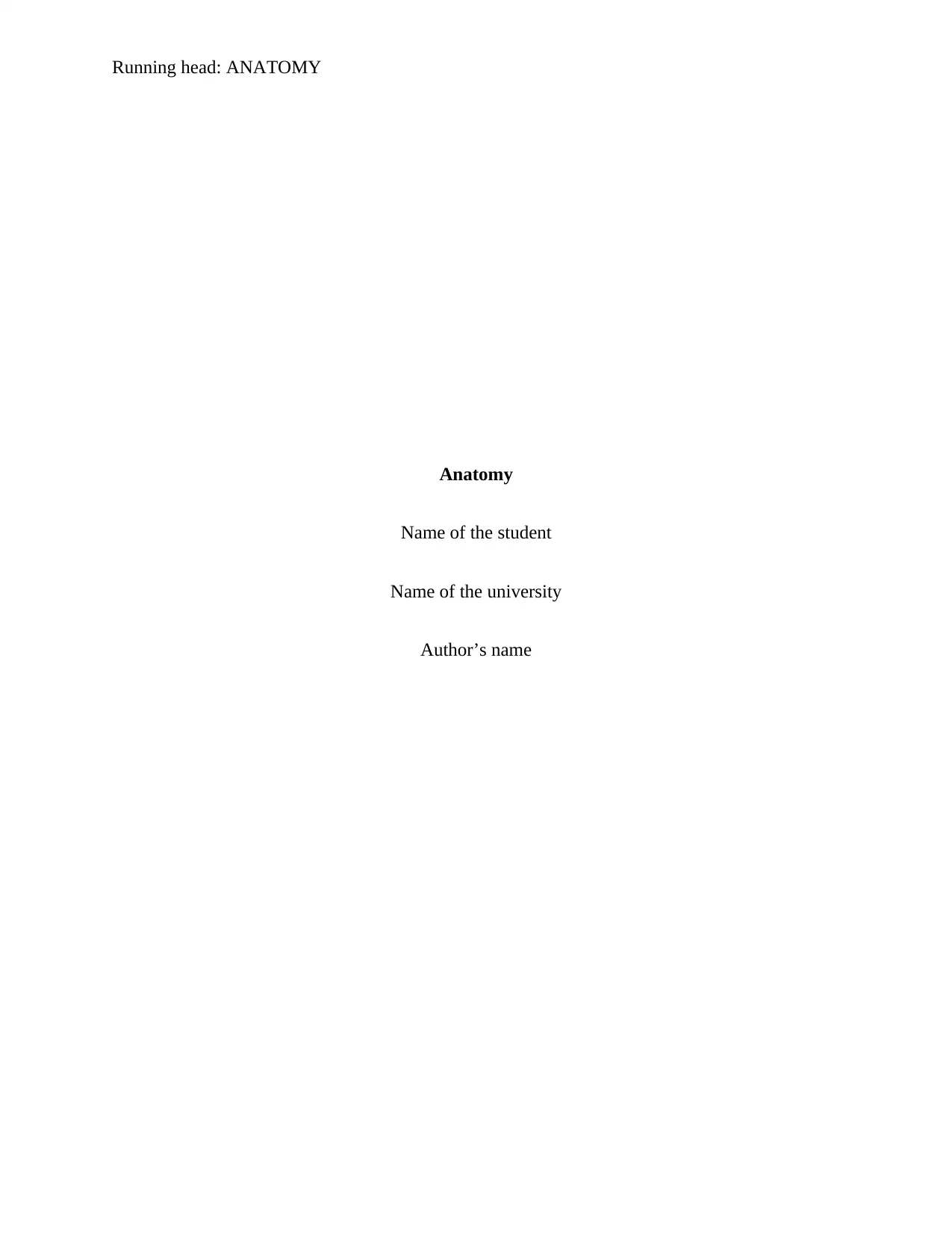
Running head: ANATOMY
Anatomy
Name of the student
Name of the university
Author’s name
Anatomy
Name of the student
Name of the university
Author’s name
Secure Best Marks with AI Grader
Need help grading? Try our AI Grader for instant feedback on your assignments.
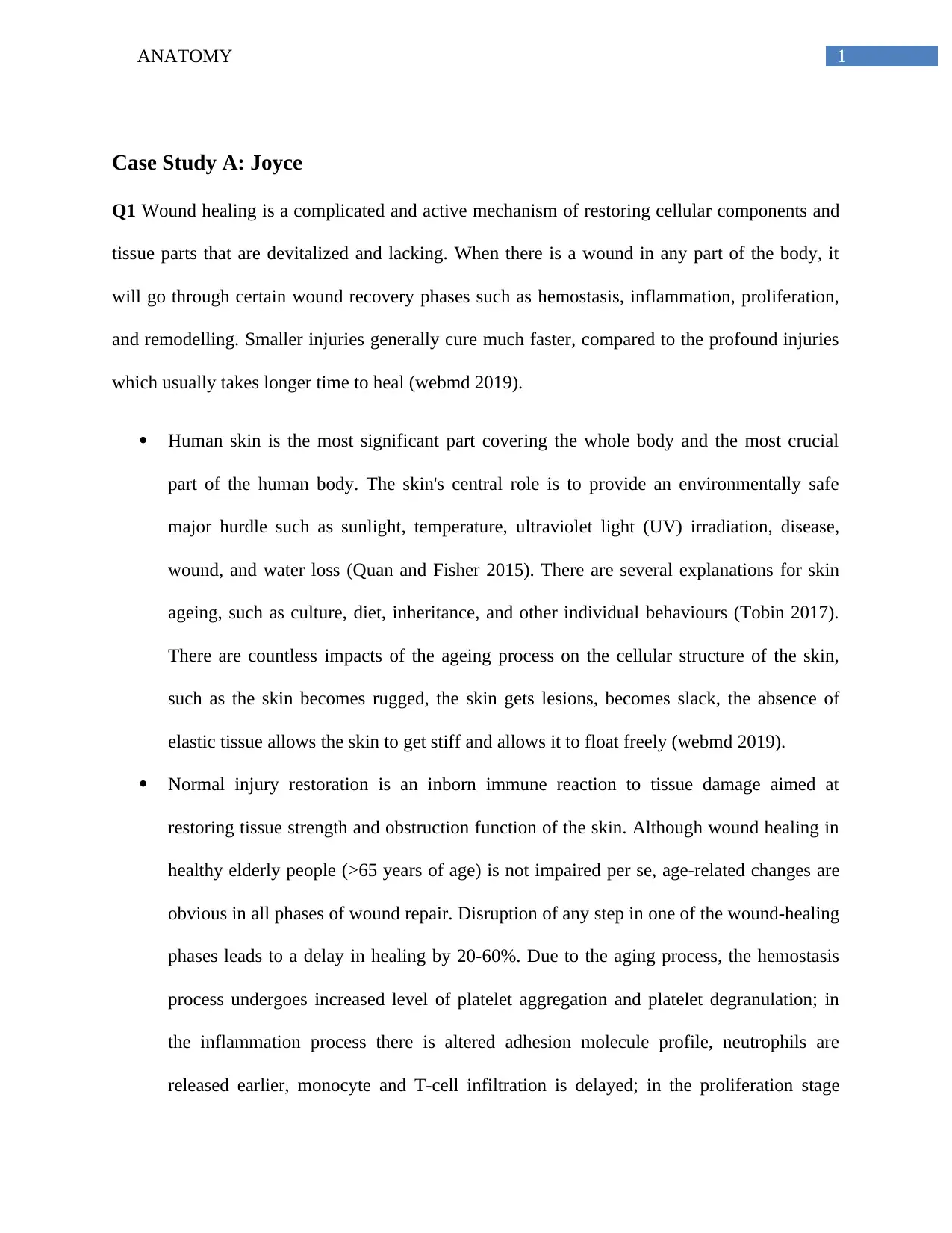
1ANATOMY
Case Study A: Joyce
Q1 Wound healing is a complicated and active mechanism of restoring cellular components and
tissue parts that are devitalized and lacking. When there is a wound in any part of the body, it
will go through certain wound recovery phases such as hemostasis, inflammation, proliferation,
and remodelling. Smaller injuries generally cure much faster, compared to the profound injuries
which usually takes longer time to heal (webmd 2019).
Human skin is the most significant part covering the whole body and the most crucial
part of the human body. The skin's central role is to provide an environmentally safe
major hurdle such as sunlight, temperature, ultraviolet light (UV) irradiation, disease,
wound, and water loss (Quan and Fisher 2015). There are several explanations for skin
ageing, such as culture, diet, inheritance, and other individual behaviours (Tobin 2017).
There are countless impacts of the ageing process on the cellular structure of the skin,
such as the skin becomes rugged, the skin gets lesions, becomes slack, the absence of
elastic tissue allows the skin to get stiff and allows it to float freely (webmd 2019).
Normal injury restoration is an inborn immune reaction to tissue damage aimed at
restoring tissue strength and obstruction function of the skin. Although wound healing in
healthy elderly people (>65 years of age) is not impaired per se, age-related changes are
obvious in all phases of wound repair. Disruption of any step in one of the wound-healing
phases leads to a delay in healing by 20-60%. Due to the aging process, the hemostasis
process undergoes increased level of platelet aggregation and platelet degranulation; in
the inflammation process there is altered adhesion molecule profile, neutrophils are
released earlier, monocyte and T-cell infiltration is delayed; in the proliferation stage
Case Study A: Joyce
Q1 Wound healing is a complicated and active mechanism of restoring cellular components and
tissue parts that are devitalized and lacking. When there is a wound in any part of the body, it
will go through certain wound recovery phases such as hemostasis, inflammation, proliferation,
and remodelling. Smaller injuries generally cure much faster, compared to the profound injuries
which usually takes longer time to heal (webmd 2019).
Human skin is the most significant part covering the whole body and the most crucial
part of the human body. The skin's central role is to provide an environmentally safe
major hurdle such as sunlight, temperature, ultraviolet light (UV) irradiation, disease,
wound, and water loss (Quan and Fisher 2015). There are several explanations for skin
ageing, such as culture, diet, inheritance, and other individual behaviours (Tobin 2017).
There are countless impacts of the ageing process on the cellular structure of the skin,
such as the skin becomes rugged, the skin gets lesions, becomes slack, the absence of
elastic tissue allows the skin to get stiff and allows it to float freely (webmd 2019).
Normal injury restoration is an inborn immune reaction to tissue damage aimed at
restoring tissue strength and obstruction function of the skin. Although wound healing in
healthy elderly people (>65 years of age) is not impaired per se, age-related changes are
obvious in all phases of wound repair. Disruption of any step in one of the wound-healing
phases leads to a delay in healing by 20-60%. Due to the aging process, the hemostasis
process undergoes increased level of platelet aggregation and platelet degranulation; in
the inflammation process there is altered adhesion molecule profile, neutrophils are
released earlier, monocyte and T-cell infiltration is delayed; in the proliferation stage
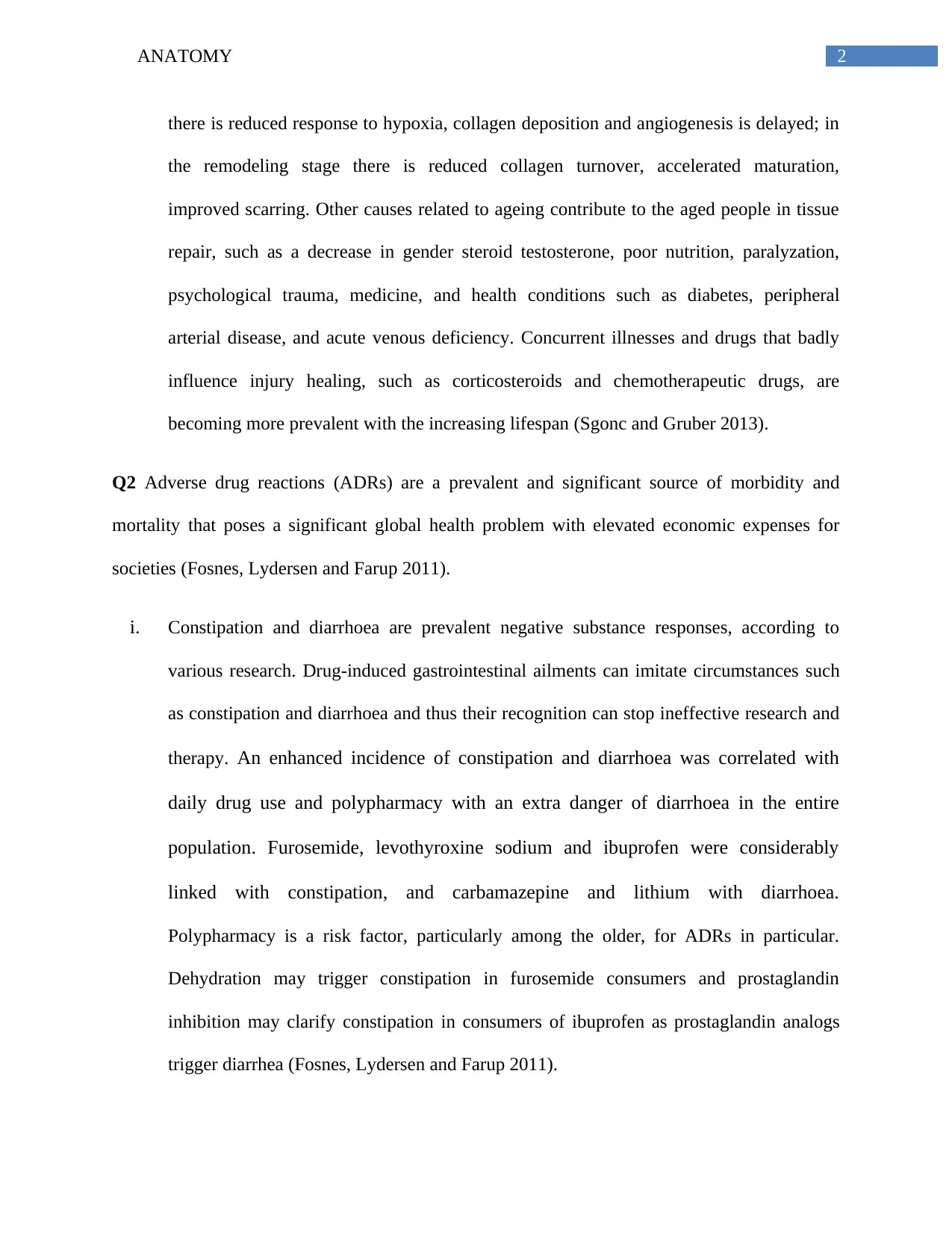
2ANATOMY
there is reduced response to hypoxia, collagen deposition and angiogenesis is delayed; in
the remodeling stage there is reduced collagen turnover, accelerated maturation,
improved scarring. Other causes related to ageing contribute to the aged people in tissue
repair, such as a decrease in gender steroid testosterone, poor nutrition, paralyzation,
psychological trauma, medicine, and health conditions such as diabetes, peripheral
arterial disease, and acute venous deficiency. Concurrent illnesses and drugs that badly
influence injury healing, such as corticosteroids and chemotherapeutic drugs, are
becoming more prevalent with the increasing lifespan (Sgonc and Gruber 2013).
Q2 Adverse drug reactions (ADRs) are a prevalent and significant source of morbidity and
mortality that poses a significant global health problem with elevated economic expenses for
societies (Fosnes, Lydersen and Farup 2011).
i. Constipation and diarrhoea are prevalent negative substance responses, according to
various research. Drug-induced gastrointestinal ailments can imitate circumstances such
as constipation and diarrhoea and thus their recognition can stop ineffective research and
therapy. An enhanced incidence of constipation and diarrhoea was correlated with
daily drug use and polypharmacy with an extra danger of diarrhoea in the entire
population. Furosemide, levothyroxine sodium and ibuprofen were considerably
linked with constipation, and carbamazepine and lithium with diarrhoea.
Polypharmacy is a risk factor, particularly among the older, for ADRs in particular.
Dehydration may trigger constipation in furosemide consumers and prostaglandin
inhibition may clarify constipation in consumers of ibuprofen as prostaglandin analogs
trigger diarrhea (Fosnes, Lydersen and Farup 2011).
there is reduced response to hypoxia, collagen deposition and angiogenesis is delayed; in
the remodeling stage there is reduced collagen turnover, accelerated maturation,
improved scarring. Other causes related to ageing contribute to the aged people in tissue
repair, such as a decrease in gender steroid testosterone, poor nutrition, paralyzation,
psychological trauma, medicine, and health conditions such as diabetes, peripheral
arterial disease, and acute venous deficiency. Concurrent illnesses and drugs that badly
influence injury healing, such as corticosteroids and chemotherapeutic drugs, are
becoming more prevalent with the increasing lifespan (Sgonc and Gruber 2013).
Q2 Adverse drug reactions (ADRs) are a prevalent and significant source of morbidity and
mortality that poses a significant global health problem with elevated economic expenses for
societies (Fosnes, Lydersen and Farup 2011).
i. Constipation and diarrhoea are prevalent negative substance responses, according to
various research. Drug-induced gastrointestinal ailments can imitate circumstances such
as constipation and diarrhoea and thus their recognition can stop ineffective research and
therapy. An enhanced incidence of constipation and diarrhoea was correlated with
daily drug use and polypharmacy with an extra danger of diarrhoea in the entire
population. Furosemide, levothyroxine sodium and ibuprofen were considerably
linked with constipation, and carbamazepine and lithium with diarrhoea.
Polypharmacy is a risk factor, particularly among the older, for ADRs in particular.
Dehydration may trigger constipation in furosemide consumers and prostaglandin
inhibition may clarify constipation in consumers of ibuprofen as prostaglandin analogs
trigger diarrhea (Fosnes, Lydersen and Farup 2011).
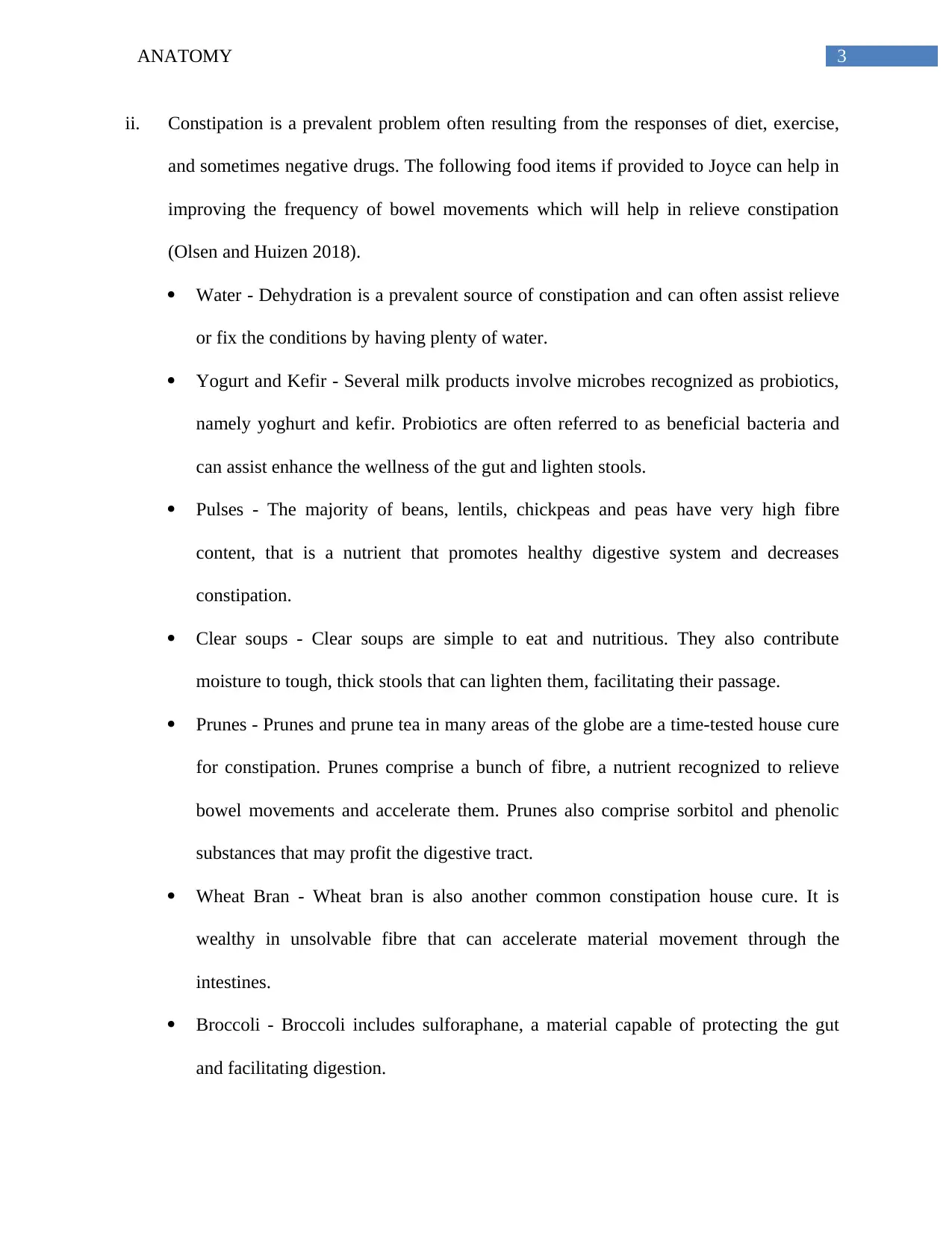
3ANATOMY
ii. Constipation is a prevalent problem often resulting from the responses of diet, exercise,
and sometimes negative drugs. The following food items if provided to Joyce can help in
improving the frequency of bowel movements which will help in relieve constipation
(Olsen and Huizen 2018).
Water - Dehydration is a prevalent source of constipation and can often assist relieve
or fix the conditions by having plenty of water.
Yogurt and Kefir - Several milk products involve microbes recognized as probiotics,
namely yoghurt and kefir. Probiotics are often referred to as beneficial bacteria and
can assist enhance the wellness of the gut and lighten stools.
Pulses - The majority of beans, lentils, chickpeas and peas have very high fibre
content, that is a nutrient that promotes healthy digestive system and decreases
constipation.
Clear soups - Clear soups are simple to eat and nutritious. They also contribute
moisture to tough, thick stools that can lighten them, facilitating their passage.
Prunes - Prunes and prune tea in many areas of the globe are a time-tested house cure
for constipation. Prunes comprise a bunch of fibre, a nutrient recognized to relieve
bowel movements and accelerate them. Prunes also comprise sorbitol and phenolic
substances that may profit the digestive tract.
Wheat Bran - Wheat bran is also another common constipation house cure. It is
wealthy in unsolvable fibre that can accelerate material movement through the
intestines.
Broccoli - Broccoli includes sulforaphane, a material capable of protecting the gut
and facilitating digestion.
ii. Constipation is a prevalent problem often resulting from the responses of diet, exercise,
and sometimes negative drugs. The following food items if provided to Joyce can help in
improving the frequency of bowel movements which will help in relieve constipation
(Olsen and Huizen 2018).
Water - Dehydration is a prevalent source of constipation and can often assist relieve
or fix the conditions by having plenty of water.
Yogurt and Kefir - Several milk products involve microbes recognized as probiotics,
namely yoghurt and kefir. Probiotics are often referred to as beneficial bacteria and
can assist enhance the wellness of the gut and lighten stools.
Pulses - The majority of beans, lentils, chickpeas and peas have very high fibre
content, that is a nutrient that promotes healthy digestive system and decreases
constipation.
Clear soups - Clear soups are simple to eat and nutritious. They also contribute
moisture to tough, thick stools that can lighten them, facilitating their passage.
Prunes - Prunes and prune tea in many areas of the globe are a time-tested house cure
for constipation. Prunes comprise a bunch of fibre, a nutrient recognized to relieve
bowel movements and accelerate them. Prunes also comprise sorbitol and phenolic
substances that may profit the digestive tract.
Wheat Bran - Wheat bran is also another common constipation house cure. It is
wealthy in unsolvable fibre that can accelerate material movement through the
intestines.
Broccoli - Broccoli includes sulforaphane, a material capable of protecting the gut
and facilitating digestion.
Secure Best Marks with AI Grader
Need help grading? Try our AI Grader for instant feedback on your assignments.

4ANATOMY
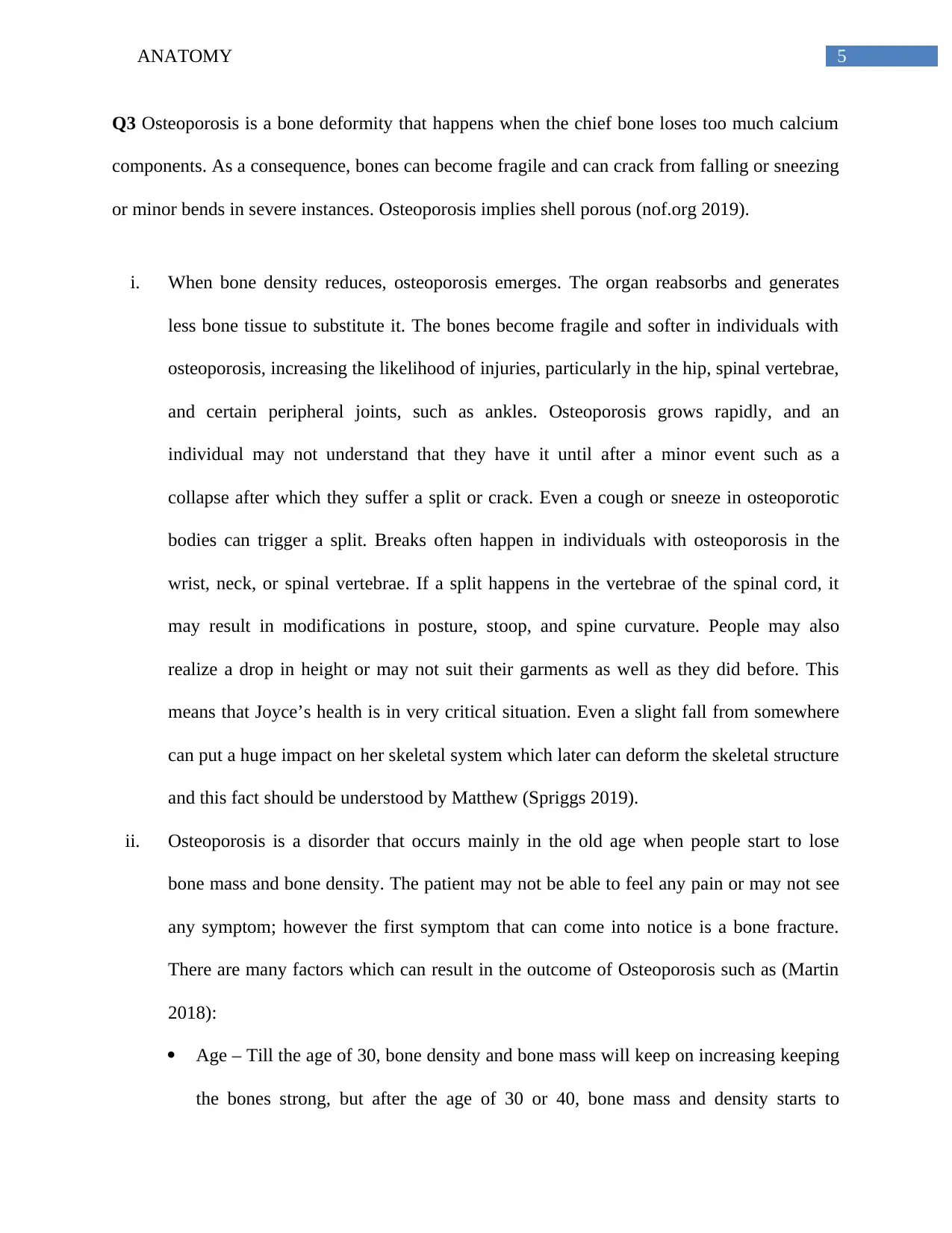
5ANATOMY
Q3 Osteoporosis is a bone deformity that happens when the chief bone loses too much calcium
components. As a consequence, bones can become fragile and can crack from falling or sneezing
or minor bends in severe instances. Osteoporosis implies shell porous (nof.org 2019).
i. When bone density reduces, osteoporosis emerges. The organ reabsorbs and generates
less bone tissue to substitute it. The bones become fragile and softer in individuals with
osteoporosis, increasing the likelihood of injuries, particularly in the hip, spinal vertebrae,
and certain peripheral joints, such as ankles. Osteoporosis grows rapidly, and an
individual may not understand that they have it until after a minor event such as a
collapse after which they suffer a split or crack. Even a cough or sneeze in osteoporotic
bodies can trigger a split. Breaks often happen in individuals with osteoporosis in the
wrist, neck, or spinal vertebrae. If a split happens in the vertebrae of the spinal cord, it
may result in modifications in posture, stoop, and spine curvature. People may also
realize a drop in height or may not suit their garments as well as they did before. This
means that Joyce’s health is in very critical situation. Even a slight fall from somewhere
can put a huge impact on her skeletal system which later can deform the skeletal structure
and this fact should be understood by Matthew (Spriggs 2019).
ii. Osteoporosis is a disorder that occurs mainly in the old age when people start to lose
bone mass and bone density. The patient may not be able to feel any pain or may not see
any symptom; however the first symptom that can come into notice is a bone fracture.
There are many factors which can result in the outcome of Osteoporosis such as (Martin
2018):
Age – Till the age of 30, bone density and bone mass will keep on increasing keeping
the bones strong, but after the age of 30 or 40, bone mass and density starts to
Q3 Osteoporosis is a bone deformity that happens when the chief bone loses too much calcium
components. As a consequence, bones can become fragile and can crack from falling or sneezing
or minor bends in severe instances. Osteoporosis implies shell porous (nof.org 2019).
i. When bone density reduces, osteoporosis emerges. The organ reabsorbs and generates
less bone tissue to substitute it. The bones become fragile and softer in individuals with
osteoporosis, increasing the likelihood of injuries, particularly in the hip, spinal vertebrae,
and certain peripheral joints, such as ankles. Osteoporosis grows rapidly, and an
individual may not understand that they have it until after a minor event such as a
collapse after which they suffer a split or crack. Even a cough or sneeze in osteoporotic
bodies can trigger a split. Breaks often happen in individuals with osteoporosis in the
wrist, neck, or spinal vertebrae. If a split happens in the vertebrae of the spinal cord, it
may result in modifications in posture, stoop, and spine curvature. People may also
realize a drop in height or may not suit their garments as well as they did before. This
means that Joyce’s health is in very critical situation. Even a slight fall from somewhere
can put a huge impact on her skeletal system which later can deform the skeletal structure
and this fact should be understood by Matthew (Spriggs 2019).
ii. Osteoporosis is a disorder that occurs mainly in the old age when people start to lose
bone mass and bone density. The patient may not be able to feel any pain or may not see
any symptom; however the first symptom that can come into notice is a bone fracture.
There are many factors which can result in the outcome of Osteoporosis such as (Martin
2018):
Age – Till the age of 30, bone density and bone mass will keep on increasing keeping
the bones strong, but after the age of 30 or 40, bone mass and density starts to
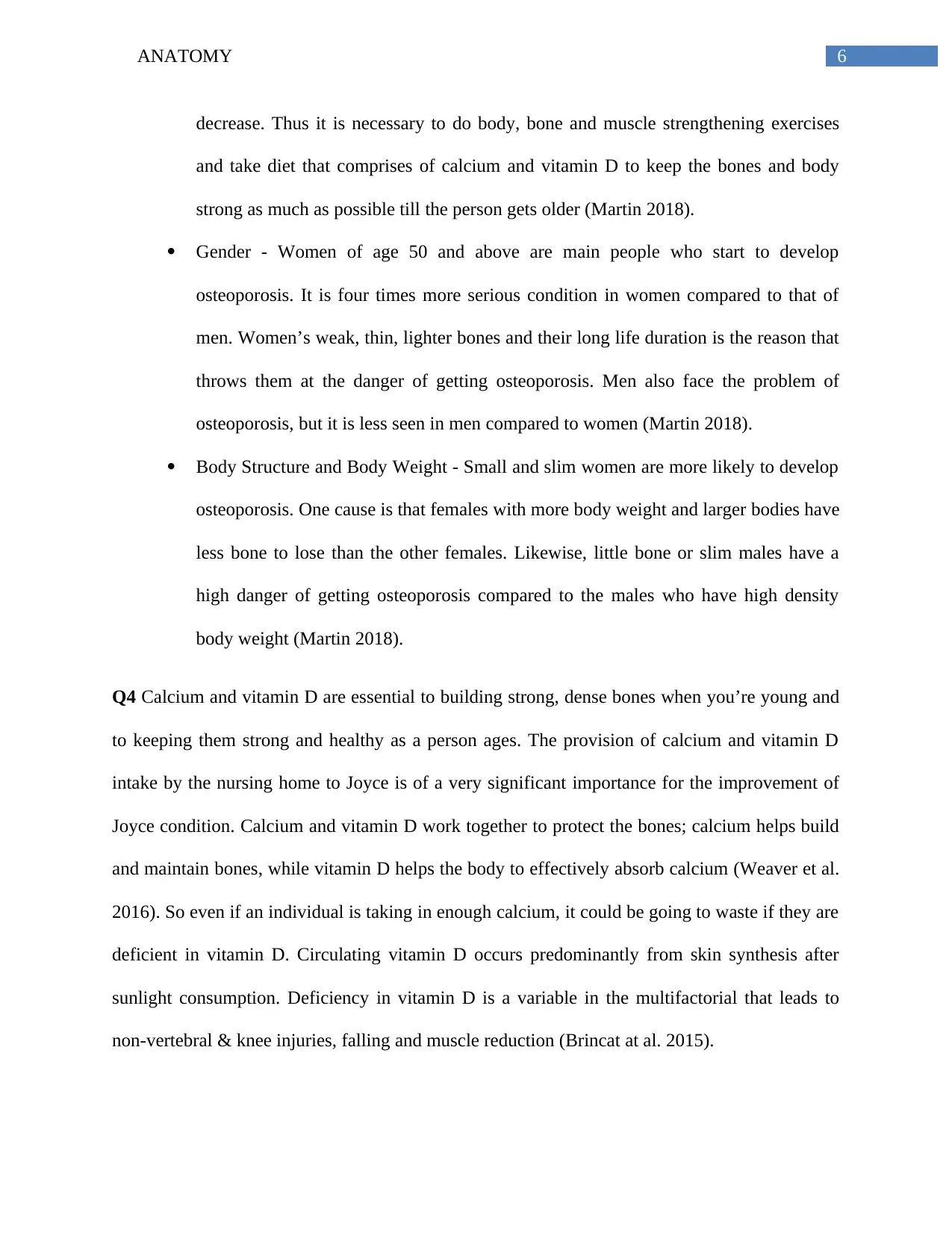
6ANATOMY
decrease. Thus it is necessary to do body, bone and muscle strengthening exercises
and take diet that comprises of calcium and vitamin D to keep the bones and body
strong as much as possible till the person gets older (Martin 2018).
Gender - Women of age 50 and above are main people who start to develop
osteoporosis. It is four times more serious condition in women compared to that of
men. Women’s weak, thin, lighter bones and their long life duration is the reason that
throws them at the danger of getting osteoporosis. Men also face the problem of
osteoporosis, but it is less seen in men compared to women (Martin 2018).
Body Structure and Body Weight - Small and slim women are more likely to develop
osteoporosis. One cause is that females with more body weight and larger bodies have
less bone to lose than the other females. Likewise, little bone or slim males have a
high danger of getting osteoporosis compared to the males who have high density
body weight (Martin 2018).
Q4 Calcium and vitamin D are essential to building strong, dense bones when you’re young and
to keeping them strong and healthy as a person ages. The provision of calcium and vitamin D
intake by the nursing home to Joyce is of a very significant importance for the improvement of
Joyce condition. Calcium and vitamin D work together to protect the bones; calcium helps build
and maintain bones, while vitamin D helps the body to effectively absorb calcium (Weaver et al.
2016). So even if an individual is taking in enough calcium, it could be going to waste if they are
deficient in vitamin D. Circulating vitamin D occurs predominantly from skin synthesis after
sunlight consumption. Deficiency in vitamin D is a variable in the multifactorial that leads to
non-vertebral & knee injuries, falling and muscle reduction (Brincat at al. 2015).
decrease. Thus it is necessary to do body, bone and muscle strengthening exercises
and take diet that comprises of calcium and vitamin D to keep the bones and body
strong as much as possible till the person gets older (Martin 2018).
Gender - Women of age 50 and above are main people who start to develop
osteoporosis. It is four times more serious condition in women compared to that of
men. Women’s weak, thin, lighter bones and their long life duration is the reason that
throws them at the danger of getting osteoporosis. Men also face the problem of
osteoporosis, but it is less seen in men compared to women (Martin 2018).
Body Structure and Body Weight - Small and slim women are more likely to develop
osteoporosis. One cause is that females with more body weight and larger bodies have
less bone to lose than the other females. Likewise, little bone or slim males have a
high danger of getting osteoporosis compared to the males who have high density
body weight (Martin 2018).
Q4 Calcium and vitamin D are essential to building strong, dense bones when you’re young and
to keeping them strong and healthy as a person ages. The provision of calcium and vitamin D
intake by the nursing home to Joyce is of a very significant importance for the improvement of
Joyce condition. Calcium and vitamin D work together to protect the bones; calcium helps build
and maintain bones, while vitamin D helps the body to effectively absorb calcium (Weaver et al.
2016). So even if an individual is taking in enough calcium, it could be going to waste if they are
deficient in vitamin D. Circulating vitamin D occurs predominantly from skin synthesis after
sunlight consumption. Deficiency in vitamin D is a variable in the multifactorial that leads to
non-vertebral & knee injuries, falling and muscle reduction (Brincat at al. 2015).
Paraphrase This Document
Need a fresh take? Get an instant paraphrase of this document with our AI Paraphraser
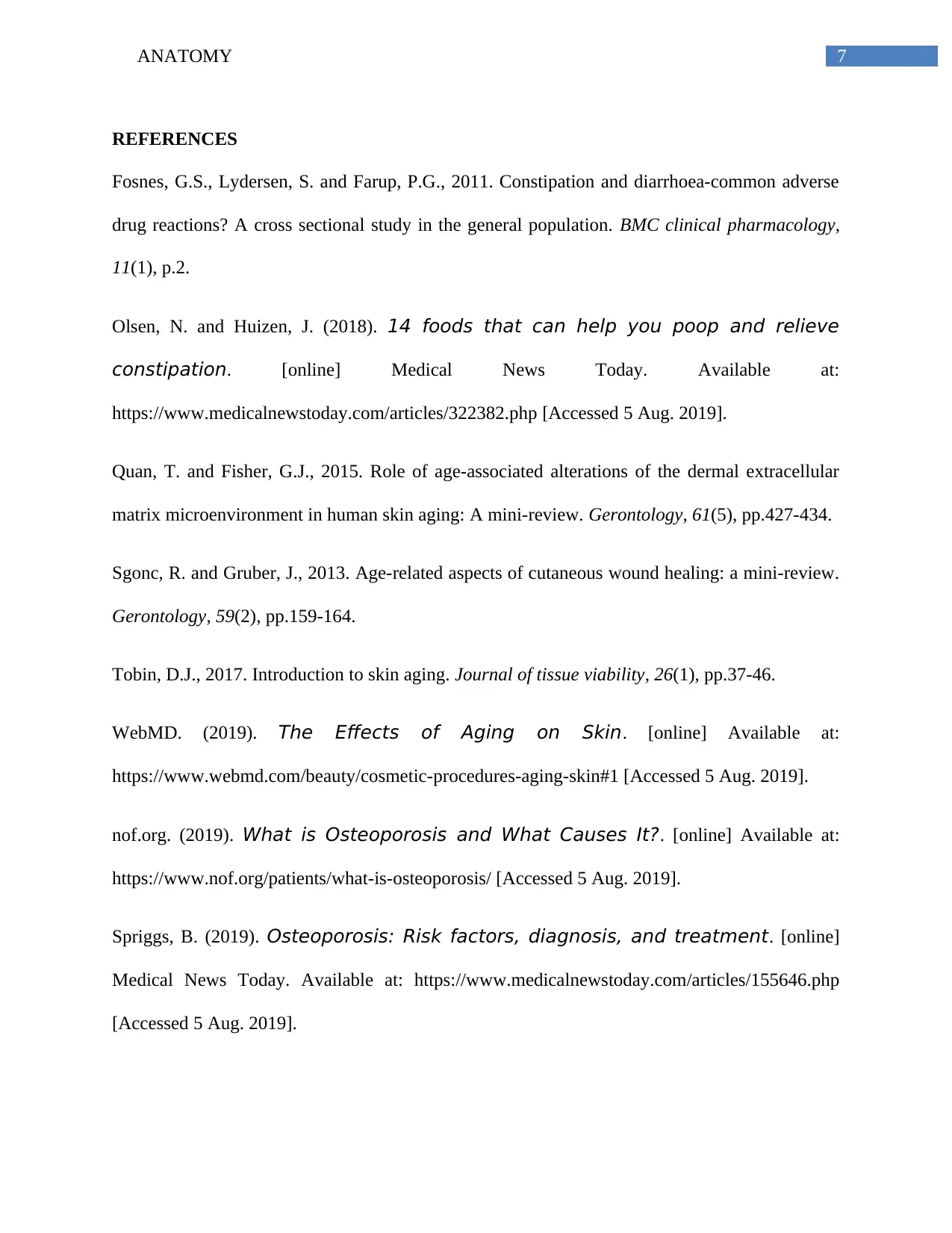
7ANATOMY
REFERENCES
Fosnes, G.S., Lydersen, S. and Farup, P.G., 2011. Constipation and diarrhoea-common adverse
drug reactions? A cross sectional study in the general population. BMC clinical pharmacology,
11(1), p.2.
Olsen, N. and Huizen, J. (2018). 14 foods that can help you poop and relieve
constipation. [online] Medical News Today. Available at:
https://www.medicalnewstoday.com/articles/322382.php [Accessed 5 Aug. 2019].
Quan, T. and Fisher, G.J., 2015. Role of age-associated alterations of the dermal extracellular
matrix microenvironment in human skin aging: A mini-review. Gerontology, 61(5), pp.427-434.
Sgonc, R. and Gruber, J., 2013. Age-related aspects of cutaneous wound healing: a mini-review.
Gerontology, 59(2), pp.159-164.
Tobin, D.J., 2017. Introduction to skin aging. Journal of tissue viability, 26(1), pp.37-46.
WebMD. (2019). The Effects of Aging on Skin. [online] Available at:
https://www.webmd.com/beauty/cosmetic-procedures-aging-skin#1 [Accessed 5 Aug. 2019].
nof.org. (2019). What is Osteoporosis and What Causes It?. [online] Available at:
https://www.nof.org/patients/what-is-osteoporosis/ [Accessed 5 Aug. 2019].
Spriggs, B. (2019). Osteoporosis: Risk factors, diagnosis, and treatment. [online]
Medical News Today. Available at: https://www.medicalnewstoday.com/articles/155646.php
[Accessed 5 Aug. 2019].
REFERENCES
Fosnes, G.S., Lydersen, S. and Farup, P.G., 2011. Constipation and diarrhoea-common adverse
drug reactions? A cross sectional study in the general population. BMC clinical pharmacology,
11(1), p.2.
Olsen, N. and Huizen, J. (2018). 14 foods that can help you poop and relieve
constipation. [online] Medical News Today. Available at:
https://www.medicalnewstoday.com/articles/322382.php [Accessed 5 Aug. 2019].
Quan, T. and Fisher, G.J., 2015. Role of age-associated alterations of the dermal extracellular
matrix microenvironment in human skin aging: A mini-review. Gerontology, 61(5), pp.427-434.
Sgonc, R. and Gruber, J., 2013. Age-related aspects of cutaneous wound healing: a mini-review.
Gerontology, 59(2), pp.159-164.
Tobin, D.J., 2017. Introduction to skin aging. Journal of tissue viability, 26(1), pp.37-46.
WebMD. (2019). The Effects of Aging on Skin. [online] Available at:
https://www.webmd.com/beauty/cosmetic-procedures-aging-skin#1 [Accessed 5 Aug. 2019].
nof.org. (2019). What is Osteoporosis and What Causes It?. [online] Available at:
https://www.nof.org/patients/what-is-osteoporosis/ [Accessed 5 Aug. 2019].
Spriggs, B. (2019). Osteoporosis: Risk factors, diagnosis, and treatment. [online]
Medical News Today. Available at: https://www.medicalnewstoday.com/articles/155646.php
[Accessed 5 Aug. 2019].
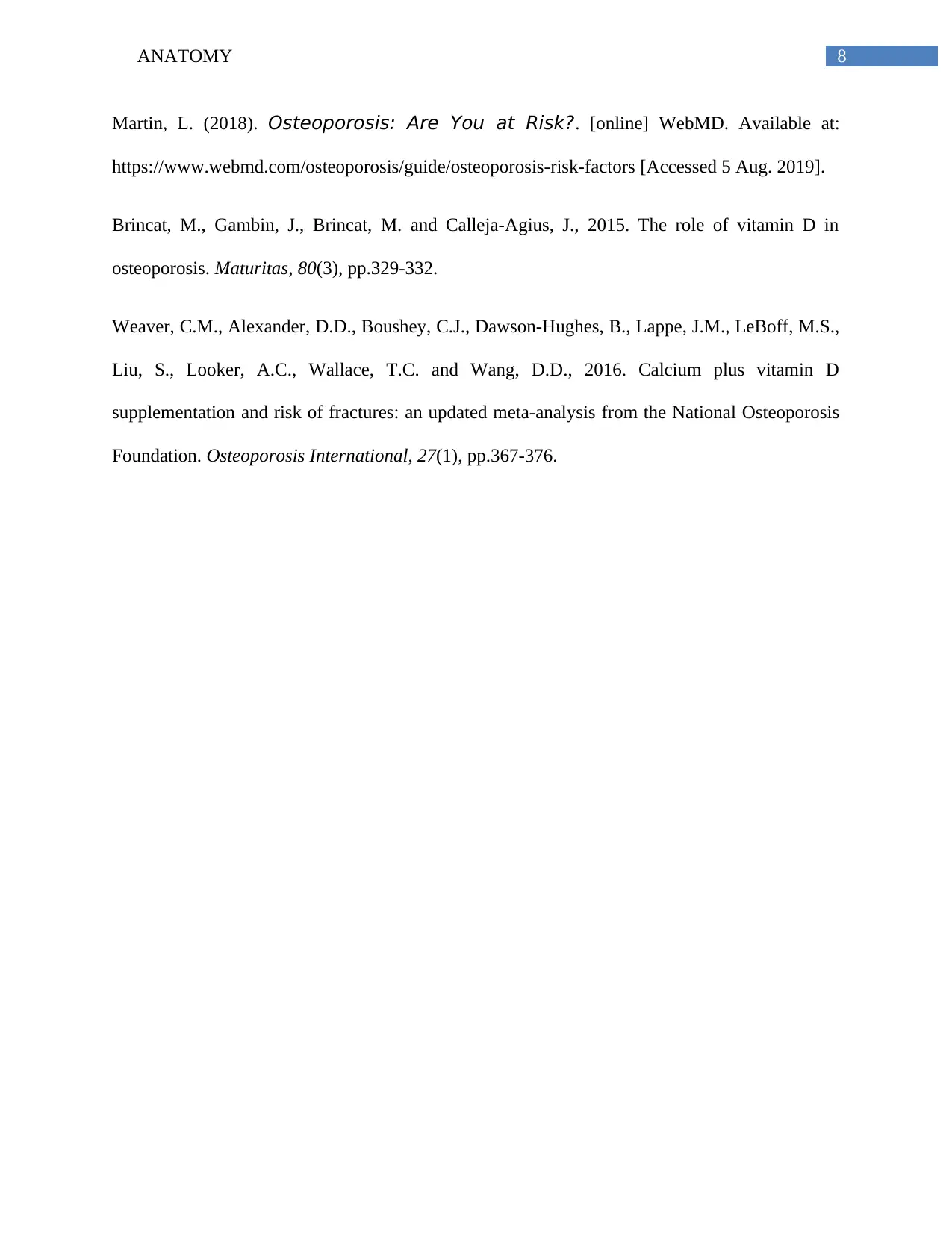
8ANATOMY
Martin, L. (2018). Osteoporosis: Are You at Risk?. [online] WebMD. Available at:
https://www.webmd.com/osteoporosis/guide/osteoporosis-risk-factors [Accessed 5 Aug. 2019].
Brincat, M., Gambin, J., Brincat, M. and Calleja-Agius, J., 2015. The role of vitamin D in
osteoporosis. Maturitas, 80(3), pp.329-332.
Weaver, C.M., Alexander, D.D., Boushey, C.J., Dawson-Hughes, B., Lappe, J.M., LeBoff, M.S.,
Liu, S., Looker, A.C., Wallace, T.C. and Wang, D.D., 2016. Calcium plus vitamin D
supplementation and risk of fractures: an updated meta-analysis from the National Osteoporosis
Foundation. Osteoporosis International, 27(1), pp.367-376.
Martin, L. (2018). Osteoporosis: Are You at Risk?. [online] WebMD. Available at:
https://www.webmd.com/osteoporosis/guide/osteoporosis-risk-factors [Accessed 5 Aug. 2019].
Brincat, M., Gambin, J., Brincat, M. and Calleja-Agius, J., 2015. The role of vitamin D in
osteoporosis. Maturitas, 80(3), pp.329-332.
Weaver, C.M., Alexander, D.D., Boushey, C.J., Dawson-Hughes, B., Lappe, J.M., LeBoff, M.S.,
Liu, S., Looker, A.C., Wallace, T.C. and Wang, D.D., 2016. Calcium plus vitamin D
supplementation and risk of fractures: an updated meta-analysis from the National Osteoporosis
Foundation. Osteoporosis International, 27(1), pp.367-376.
1 out of 9
Related Documents
Your All-in-One AI-Powered Toolkit for Academic Success.
+13062052269
info@desklib.com
Available 24*7 on WhatsApp / Email
![[object Object]](/_next/static/media/star-bottom.7253800d.svg)
Unlock your academic potential
© 2024 | Zucol Services PVT LTD | All rights reserved.





